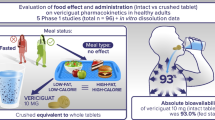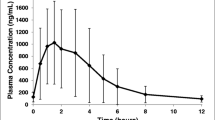Summary
The relative bioavailability in 20 healthy volunteers of 100 mg, 200 mg and 300 mg tablets of noscapine and 200 mg as a solution has been assessed in a four-way cross-over study, with repeated administration of the 200 mg dose to assess intraindividual variability. There was a disproportionate increase in the AUC of noscapine tablets, as a 3-fold increase in dose produced a 9-fold rise in AUC. This dose-dependency could mainly be attributed to saturable first-pass metabolism of the drug. Administration of noscapine as a solution resulted in a significantly higher maximal concentration at an earlier time-point and a higher AUC than the corresponding dose as tablets. Repeated administration of noscapine tablets and solution yielded higher AUC on the second dosing occasion. No cause for this carry-over effect was found, and the contribution of remaining noscapine was negligible. The terminal half-life of noscapine, which was independent of formulation or dose size was 4.5 h. Both inter- and intraindividual variability in noscapine kinetics were very high, e.g. 73% and 51% CV of the AUC for the 200 mg tablet.
Similar content being viewed by others
References
Balint G, Rabloczky G (1968) Antitussive effect of autonomic drugs. Acta Physiol Acad Sci Hung 33: 99–109
Bickerman HA, German E, Cohen BM, Itkin SE (1957) The cough response of healthy human subjects stimulated by citric acid aerosol. Part II: Evaluation of antitussive agents. Am J Med Sci 234: 191–206
Craviso GL, Musacchio JM (1983) High-affinity dextromethorphan binding sites in guinea pig brain. II. Competition experiments. Mol Pharmacol 23: 629–640
Dahlström B, Mellstrand T, Löfdahl C-G, Johansson M (1982) Pharmacokinetic properties of noscapine. Eur J Clin Pharmacol 22: 535–539
Empey DW, Laitinen LA, Young GA, Bye CE, Hughes DTD (1979) Comparison of the antitussive effects of codeine phosphate 20 mg, dextromethorphan 30 mg and noscapine 30 mg using citric acid-induced cough in normal subjects. Eur J Clin Pharmacol 16: 393–397
Gibaldi M, Perrier D (1982) Pharmacokinetics, 2nd edn. Dekker, New York
Haikala V, Sothman A, Marvola M (1986) Comparative Bioavailability and pharmacokinetics of noscapine hydrogen embonate and noscapine hydrochloride. Eur J Clin Pharmacol 31: 367–369
Idänpään-Heikkilä JE, Jalonen K, Vartiainen A (1967) Evaluation of the antitussive effect of noscapine and codeine on citric acid cough in guinea-pigs. Acta Pharmacol Toxicol 25: 333–338
Johansson M, Tufvesson Alm A, Forsmo-Bruce H, Jacobsson S, Westerlund D (1988) Determination of noscapine and its metabolites in plasma using coupled column liquid chromatography. J Chromatogr 459: 301–311
Karlsson MO, Dahlström B, Neil A (1988) Characterization of high-affinity binding sites for the antitussive [3H]noscapine in guinea pig brain tissue. Eur J Pharmacol 145: 195–203
Karlsson MO, Neil A (1988) Estimation of binding parameters by kinetic data analysis: differentiation between one and two binding sites. Eur J Pharmacol 148: 115–121
Martindale, The Extra Pharmacopeia (1977) A Wade (ed) 27th edn. The Pharmaceutical Press, London, p 1250
Martis L, Levy R (1973) Bioavailability calculations for drugs showing simultaneous first-order and capacity-limited elimination kinetics. J Pharmacokinet Biopharm 1: 283–294
Matthys H, Erhardt J, Rühle K-H (1985) Objectivierung der Wirkung von Antitussiva mittels Tussometrie an Patienten mit chronischem Husten. Schweiz Med Wochenschr 115: 307–311
Rubin GM, Tozer TN (1984) Theoretical considerations in the calculation of bioavailability of drugs exhibiting Michaelis-Menten elimination kinetics. J Pharmacokinet Biopharm 12: 437–450
Steiner E, Bertilsson L, Säwe J, Bertling I, Sjökvist F (1988) Polymorphic debrisoquine hydroxylation in 757 Swedish subjects. Clin Pharmacol Ther 44: 431–435
Tsunoda N, Yosimura H (1979) Metabolic fate of noscapine. II. Isolation and identification of novel metabolites produced by C-C bond cleavage. Xenobiotica 9: 181–187
Tsunoda N, Yosimura H (1981) Metabolic fate of noscapine. III. Further studies on identification and determination of the metabolites. Xenobiotica 11: 23–32
Vedsö S (1961) Absorption and excretion of noscapine. Acta Pharmacol Toxicol 18: 157–164
Winter CA, Flataker L (1954) Antitussive compounds: testing methods and results. J Pharmacol 112: 99–108
Author information
Authors and Affiliations
Rights and permissions
About this article
Cite this article
Karlsson, M.O., Dahlström, B., Eckernäs, SÅ. et al. Pharmacokinetics of oral noscapine. Eur J Clin Pharmacol 39, 275–279 (1990). https://doi.org/10.1007/BF00315110
Received:
Accepted:
Issue Date:
DOI: https://doi.org/10.1007/BF00315110




